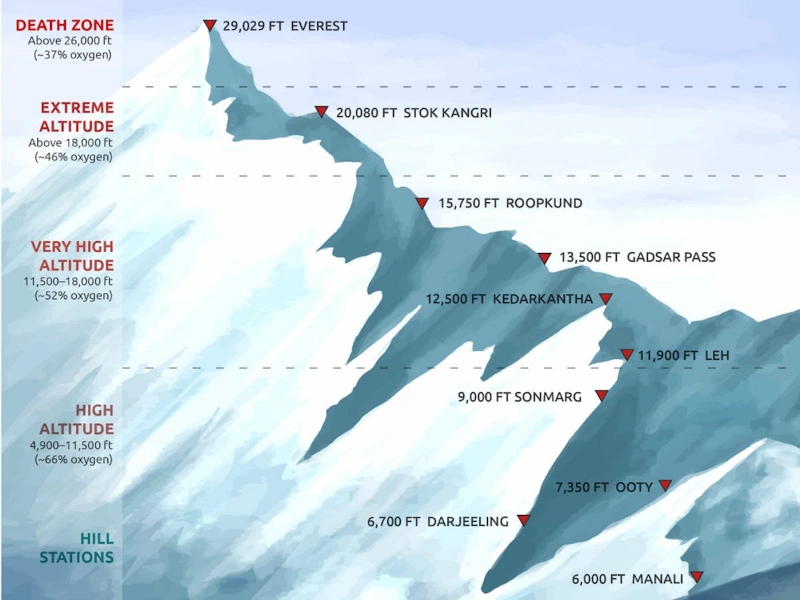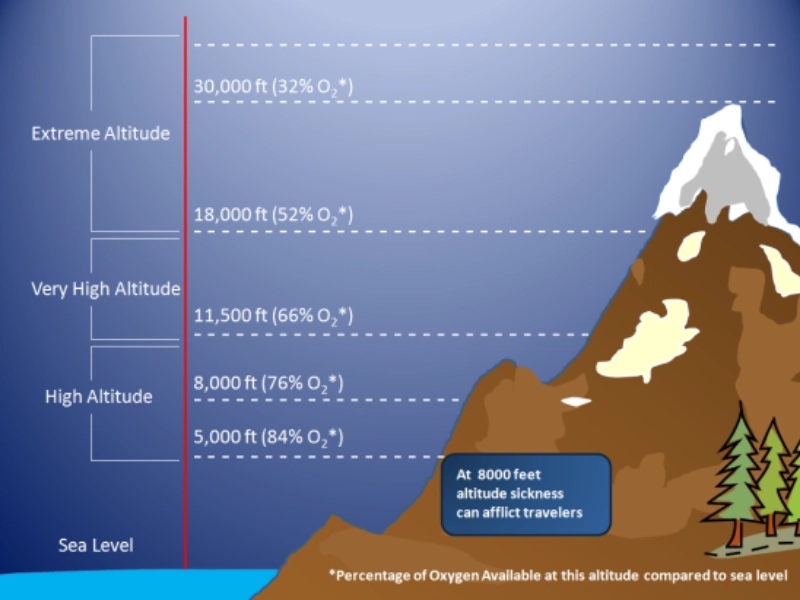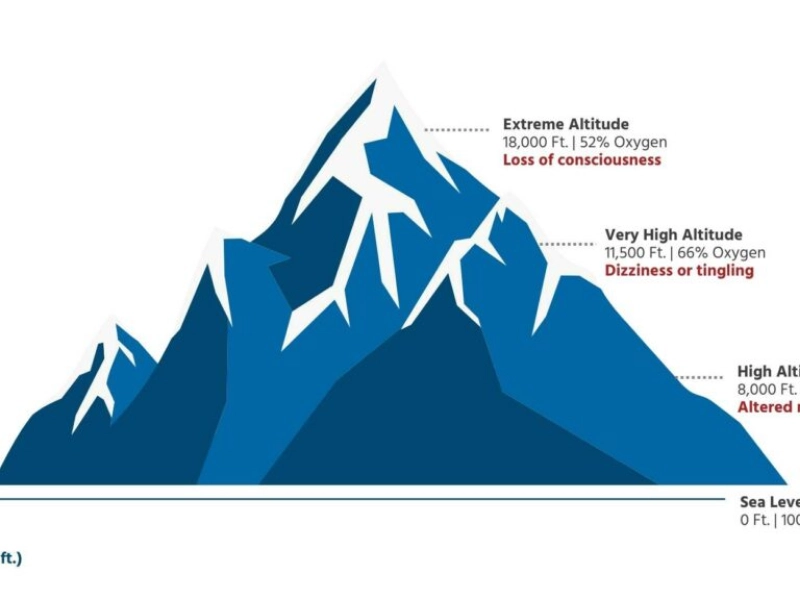Does the Effect of Altitude Increase with Age?Every year, millions of people travel to high altitudes for sports, vacation, and permanent habitation. While some people do well in these conditions, others find it challenging. A number of elderly enthusiasts of alpine sports have observed that they are less susceptible to altitude sickness than younger hikers, skiers, and climbers. Does age, however, actually matter?
 The distance between Earth's surface and the atmospheric molecules determines air pressure. The pressure increases with the number of molecules. Because the molecules in the atmosphere are wider apart at high elevations, the air pressure is lower. Because there is just less air to pull in, this is also the reason why breathing at very high elevations might feel more difficult.
In one investigation, scientists discovered a substantial correlation between oxygen saturation at sea level and atmospheric pressure. They did not discover, however, a correlation between greater dyspnea and a drop in air pressure. This result might be due to the fact that variables other than air pressure, including self-reported heart disease or spirometry-measured lung function, are predictive of elevated dyspnea.
The distance between Earth's surface and the atmospheric molecules determines air pressure. The pressure increases with the number of molecules. Because the molecules in the atmosphere are wider apart at high elevations, the air pressure is lower. Because there is just less air to pull in, this is also the reason why breathing at very high elevations might feel more difficult.
In one investigation, scientists discovered a substantial correlation between oxygen saturation at sea level and atmospheric pressure. They did not discover, however, a correlation between greater dyspnea and a drop in air pressure. This result might be due to the fact that variables other than air pressure, including self-reported heart disease or spirometry-measured lung function, are predictive of elevated dyspnea.
 Normally, breathing happens automatically and without conscious thought. That's why it can be quite terrifying when someone is out of breath. It can occur during intense physical activity, when ascending to a high altitude, or during an abrupt temperature shift, but it can also indicate certain conditions that need to be treated by a doctor.
Usually, when someone relaxes or quits doing whatever is aggravating the situation, the dyspnea subsides. But they ought to receive medical attention if it doesn't go away or if it becomes worse. Breathing problems, or dyspnea, can be a sign of a number of illnesses, such as asthma and heart attacks.
By performing an examination and asking questions of the patient, a doctor can diagnose dyspnea. They may administer lung function tests to the patient or assess blood oxygen levels with a pulse oximeter, a gadget that looks like it belongs on scuba divers. Additional techniques for diagnosis include electrocardiograms, computed tomography (CT) scans, and spirometry tests, which measure lung function.
Normally, breathing happens automatically and without conscious thought. That's why it can be quite terrifying when someone is out of breath. It can occur during intense physical activity, when ascending to a high altitude, or during an abrupt temperature shift, but it can also indicate certain conditions that need to be treated by a doctor.
Usually, when someone relaxes or quits doing whatever is aggravating the situation, the dyspnea subsides. But they ought to receive medical attention if it doesn't go away or if it becomes worse. Breathing problems, or dyspnea, can be a sign of a number of illnesses, such as asthma and heart attacks.
By performing an examination and asking questions of the patient, a doctor can diagnose dyspnea. They may administer lung function tests to the patient or assess blood oxygen levels with a pulse oximeter, a gadget that looks like it belongs on scuba divers. Additional techniques for diagnosis include electrocardiograms, computed tomography (CT) scans, and spirometry tests, which measure lung function.
 There is less oxygen in the air at higher elevations than there is in the lower ones. The drop in blood oxygen levels that occurs during ascent might lead to malfunctions in bodily functioning. We refer to this as hypoxemia.
At high altitudes, the oxygen saturation of hemoglobin, the protein that carries oxygen in the blood, starts to rapidly decrease. The normal range for oxygen saturation in a healthy individual is 95% to 100%. A pulse oximeter is a finger-clipping gadget that you may use at home to measure your own oxygen saturation. It reads your blood oxygen level as a percentage.
According to one study, men and women react to altitude in identical ways, but postmenopausal women find it more difficult to acclimate. This is a result of menopausal hormone changes, which may affect breathing. Because of this, older people should take the usual guidelines for ascent rate seriously and give themselves more time to acclimate before engaging in physical activity at an altitude.
There is less oxygen in the air at higher elevations than there is in the lower ones. The drop in blood oxygen levels that occurs during ascent might lead to malfunctions in bodily functioning. We refer to this as hypoxemia.
At high altitudes, the oxygen saturation of hemoglobin, the protein that carries oxygen in the blood, starts to rapidly decrease. The normal range for oxygen saturation in a healthy individual is 95% to 100%. A pulse oximeter is a finger-clipping gadget that you may use at home to measure your own oxygen saturation. It reads your blood oxygen level as a percentage.
According to one study, men and women react to altitude in identical ways, but postmenopausal women find it more difficult to acclimate. This is a result of menopausal hormone changes, which may affect breathing. Because of this, older people should take the usual guidelines for ascent rate seriously and give themselves more time to acclimate before engaging in physical activity at an altitude.
 Altitude sickness can affect even physically fit and well-healthy individuals. It occurs when you go swiftly to high altitudes and your body finds it difficult to adapt to the lower air quality. Symptoms like nausea, headaches, and fatigue are possible. Altitude sickness can be prevented by drinking lots of water, abstaining from alcohol, cigarette products, and sleeping medications. For the first 24 hours at altitude, refrain from strenuous activities to expedite the process of acclimatization.
By giving your body time to acclimate and taking acetazolamide or dexamethasone before to traveling to high elevations, you can avoid altitude sickness. These drugs lower blood oxygen levels and slow the pace at which fluid escapes from small blood arteries. Pulmonary edema is the most serious type of altitude sickness, characterized by an accumulation of fluid in the lungs. If treatment for this condition is delayed, it may prove to be fatal. Extremity edema, dyspnea, and a strong cough are among the signs and symptoms of HAPE.
Altitude sickness can affect even physically fit and well-healthy individuals. It occurs when you go swiftly to high altitudes and your body finds it difficult to adapt to the lower air quality. Symptoms like nausea, headaches, and fatigue are possible. Altitude sickness can be prevented by drinking lots of water, abstaining from alcohol, cigarette products, and sleeping medications. For the first 24 hours at altitude, refrain from strenuous activities to expedite the process of acclimatization.
By giving your body time to acclimate and taking acetazolamide or dexamethasone before to traveling to high elevations, you can avoid altitude sickness. These drugs lower blood oxygen levels and slow the pace at which fluid escapes from small blood arteries. Pulmonary edema is the most serious type of altitude sickness, characterized by an accumulation of fluid in the lungs. If treatment for this condition is delayed, it may prove to be fatal. Extremity edema, dyspnea, and a strong cough are among the signs and symptoms of HAPE.